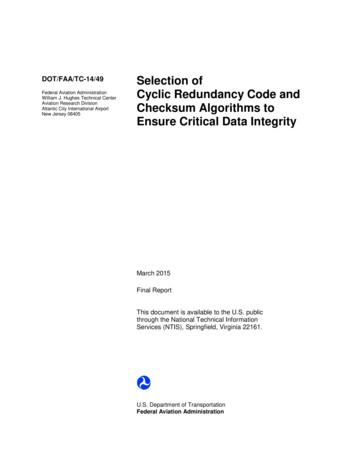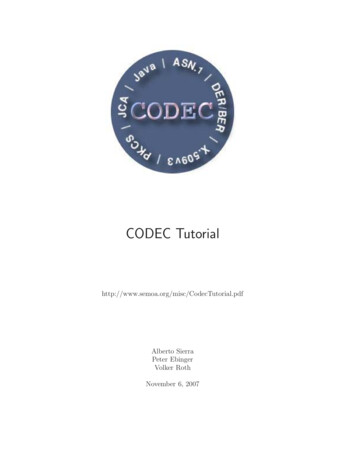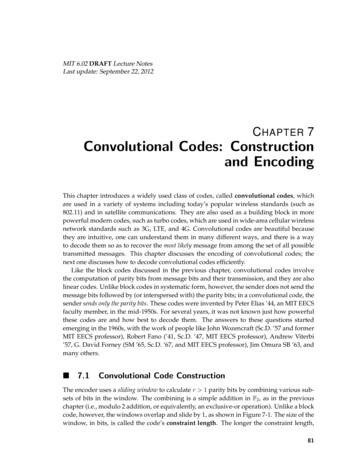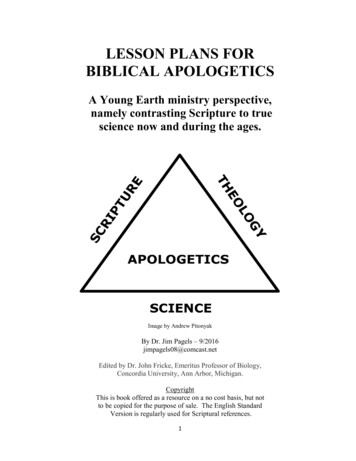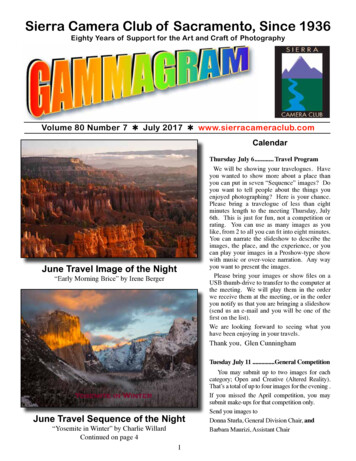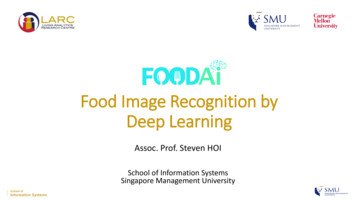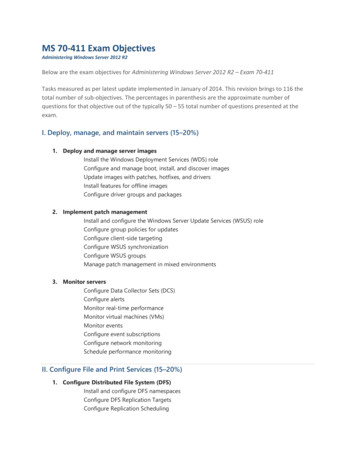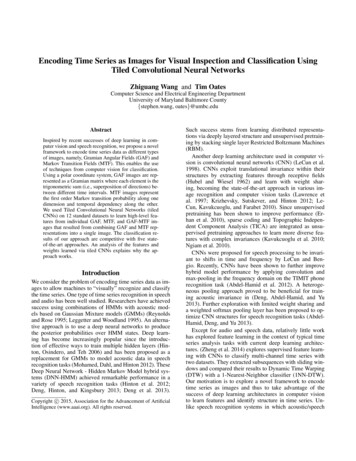
Transcription
Encoding Time Series as Images for Visual Inspection and Classification UsingTiled Convolutional Neural NetworksZhiguang Wang and Tim OatesComputer Science and Electrical Engineering DepartmentUniversity of Maryland Baltimore County{stephen.wang, oates}@umbc.eduAbstractInspired by recent successes of deep learning in computer vision and speech recognition, we propose a novelframework to encode time series data as different typesof images, namely, Gramian Angular Fields (GAF) andMarkov Transition Fields (MTF). This enables the useof techniques from computer vision for classification.Using a polar coordinate system, GAF images are represented as a Gramian matrix where each element is thetrigonometric sum (i.e., superposition of directions) between different time intervals. MTF images representthe first order Markov transition probability along onedimension and temporal dependency along the other.We used Tiled Convolutional Neural Networks (tiledCNNs) on 12 standard datasets to learn high-level features from individual GAF, MTF, and GAF-MTF images that resulted from combining GAF and MTF representations into a single image. The classification results of our approach are competitive with five stateof-the-art approaches. An analysis of the features andweights learned via tiled CNNs explains why the approach works.IntroductionWe consider the problem of encoding time series data as images to allow machines to “visually” recognize and classifythe time series. One type of time series recognition in speechand audio has been well studied. Researchers have achievedsuccess using combinations of HMMs with acoustic models based on Gaussian Mixture models (GMMs) (Reynoldsand Rose 1995; Leggetter and Woodland 1995). An alternative approach is to use a deep neural networks to producethe posterior probabilities over HMM states. Deep learning has become increasingly popular since the introduction of effective ways to train multiple hidden layers (Hinton, Osindero, and Teh 2006) and has been proposed as areplacement for GMMs to model acoustic data in speechrecognition tasks (Mohamed, Dahl, and Hinton 2012). TheseDeep Neural Network - Hidden Markov Model hybrid systems (DNN-HMM) achieved remarkable performance in avariety of speech recognition tasks (Hinton et al. 2012;Deng, Hinton, and Kingsbury 2013; Deng et al. 2013).Copyright c 2015, Association for the Advancement of ArtificialIntelligence (www.aaai.org). All rights reserved.Such success stems from learning distributed representations via deeply layered structure and unsupervised pretraining by stacking single layer Restricted Boltzmann Machines(RBM).Another deep learning architecture used in computer vision is convolutional neural networks (CNN) (LeCun et al.1998). CNNs exploit translational invariance within theirstructures by extracting features through receptive fields(Hubel and Wiesel 1962) and learn with weight sharing, becoming the state-of-the-art approach in various image recognition and computer vision tasks (Lawrence etal. 1997; Krizhevsky, Sutskever, and Hinton 2012; LeCun, Kavukcuoglu, and Farabet 2010). Since unsupervisedpretraining has been shown to improve performance (Erhan et al. 2010), sparse coding and Topographic Independent Component Analysis (TICA) are integrated as unsupervised pretraining approaches to learn more diverse features with complex invariances (Kavukcuoglu et al. 2010;Ngiam et al. 2010).CNNs were proposed for speech processing to be invariant to shifts in time and frequency by LeCun and Bengio. Recently, CNNs have been shown to further improvehybrid model performance by applying convolution andmax-pooling in the frequency domain on the TIMIT phonerecognition task (Abdel-Hamid et al. 2012). A heterogeneous pooling approach proved to be beneficial for training acoustic invariance in (Deng, Abdel-Hamid, and Yu2013). Further exploration with limited weight sharing anda weighted softmax pooling layer has been proposed to optimize CNN structures for speech recognition tasks (AbdelHamid, Deng, and Yu 2013).Except for audio and speech data, relatively little workhas explored feature learning in the context of typical timeseries analysis tasks with current deep learning architectures. (Zheng et al. 2014) explores supervised feature learning with CNNs to classify multi-channel time series withtwo datasets. They extracted subsequences with sliding windows and compared their results to Dynamic Time Warping(DTW) with a 1-Nearest-Neighbor classifier (1NN-DTW).Our motivation is to explore a novel framework to encodetime series as images and thus to take advantage of thesuccess of deep learning architectures in computer visionto learn features and identify structure in time series. Unlike speech recognition systems in which acoustic/speech
data input is typically represented by concatenating Melfrequency cepstral coefficients (MFCCs) or perceptual linear predictive coefficient (PLPs) (Hermansky 1990), typicaltime series data are not likely to benefit from transformationstypically applied to speech or acoustic data.In this paper, we present two new representations for encoding time series as images that we call them Gramian Angular Field (GAF) and the Markov Transition Field (MTF).We select the same twelve “hard” time series dataset usedby Oates et al., and applied deep Tiled Convolutional NeuralNetworks (Tiled CNN) with a pretraining stage that exploitslocal orthogonality by Topographic ICA (Ngiam et al. 2010)to “visually” represent the time series. We report our classification performance both on GAF and MTF separately,and GAF-MTF which resulted from combining GAF andMTF representations into a single image. By comparing ourresults with five previous and current state-of-the-art handcrafted representation and classification methods, we showthat our approach in practice achieves competitive performance with the state of the art while exploring a relativelysmall parameter space. We also find that our Tiled CNNbased deep learning method works well with small time series datasets, while the traditional CNN may not work wellon such small datasets (Zheng et al. 2014). In addition to exploring the high level features learned by Tiled CNNs, weprovide an in-depth analysis in terms of the duality betweentime series and images within our frameworks that more precisely identifies the reasons why our approaches work.Encoding Time Series to ImagesWe first introduce our two frameworks for encoding time series as images. The first type of image is a Gramian Angularfield (GAF), in which we represent time series in a polar coordinate system instead of the typical Cartesian coordinates.In the Gramian matrix, each element is actually the cosine ofthe summation of angles. Inspired by previous work on theduality between time series and complex networks (Campanharo et al. 2011), the main idea of the second framework,the Markov Transition Field (MTF), is to build the Markovmatrix of quantile bins after discretization and encode thedynamic transition probability in a quasi-Gramian matrix.Gramian Angular FieldGiven a time series X {x1 , x2 , ., xn } of n real-valuedobservations, we rescale X so that all values fall in the interval [ 1, 1]:x̃i (xi max(X) (xi min(X))max(X) min(X)(1)Thus we can represent the rescaled time series X̃ in polarcoordinates by encoding the value as the angular cosine andtime stamp as the radius with the equation below: φ arccos (x̃i ), 1 x̃i 1, x̃i X̃(2)tir N, ti NIn the equation above, ti is the time stamp and N is aconstant factor to regularize the span of the polar coordinate system. This polar coordinate based representation is aPolar CoordinateTime Series 𝑋Gramian Angular FieldFigure 1: Illustration of the proposed encoding map ofGramian Angular Field. X is a sequence of typical time series in dataset ’SwedishLeaf’. After X is rescaled by eq. (1)and smoothed by PAA optionally, we transform it into polarcoordinate system by eq. (2) and finally calculate its GAFimage with eq. (4). In this example, we build GAF without PAA smoothing, so the GAF has a high resolution of128 128.novel way to understand time series. As time increases, corresponding values warp among different angular points onthe spanning circles, like water rippling. The encoding mapof equation 2 has two important properties. First, it is bijective as cos(φ) is monotonic when φ [0, π]. Given a timeseries, the proposed map produces one and only one result inthe polar coordinate system with a unique inverse function.Second, as opposed to Cartesian coordinates, polar coordinates preserve absolute temporal relations. In Cartesian coR x( j)ordinates, the area is defined by Si,j x(i)f (x(t))dx(t),we have Si,i k Sj,j k if f (x(t)) has the same valueson [i, i k] and [j, j k]. However, in polar coordinates,R φ(j)0if the area is defined as Si,j φ(i) r[φ(t)]2 d(φ(t)), then00Si,i k6 Sj,j k. That is, the corresponding area from timestamp i to time stamp j is not only dependent on the timeinterval i j , but also determined by the absolute value ofi and j. We will discuss this in more detail in another work.After transforming the rescaled time series into the polar coordinate system, we can easily exploit the angular perspective by considering the trigonometric sum between eachpoint to identify the temporal correlation within differenttime intervals. The GAF is defined as follows: cos(φ1 φ1 ) · · · cos(φ1 φn ) cos(φ2 φ1 ) · · · cos(φ2 φn ) (3)G . .cos(φn φ1 ) · · · cos(φn φn )p0 p X̃ 0 · X̃ I X̃ 2 · I X̃ 2(4)I is the unit row vector [1, 1, ., 1]. After transforming tothe polar coordinate system, we take time series at each timestep as a 1-D metric space. By pdefining the inner product x, y x · y 1 x2 · 1 y 2 , G is a Gramianmatrix:
x 1 , x 1 x 2 , x 1 . .······. x 1 , x n x 2 , x n . . x n , x 1 ··· x n , x n ABC DMarkov Transition FieldWe propose a framework similar to (Campanharo et al.2011) for encoding dynamical transition statistics, but weextend that idea by representing the Markov transition probabilities sequentially to preserve information in the time domain.Given a time series X, we identify its Q quantile bins andassign each xi to the corresponding bins qj (j [1, Q]).Thus we construct a Q Q weighted adjacency matrix Wby counting transitions among quantile bins in the manner ofa first-order Markov chain along the time axis. wi,j is givenby the frequency with which a point in the quantile qj is followed by a point in the quantile qi . After normalization byPj wij 1, W is the Markov transition matrix. It is insensitive to the distribution of X and temporal dependency ontime steps ti . However, getting rid of the temporal dependency results in too much information loss in matrix W . Toovercome this drawback, we define the Markov TransitionField (MTF) as follows: w ··· wij x1 qi ,x1 qjij x1 qi ,xn qj···.···wij x2 qi ,xn qj . .wij xn qi ,xn qjB0.0830.5830.2600.083C00.3340.5220.167DMarkov Transition Matrx000.2180.75DDThe GAF has several advantages. First, it provides a wayto preserve the temporal dependency, since time increases asthe position moves from top-left to bottom-right. The GAFcontains temporal correlations because G(i,j i j k) represents the relative correlation by superposition of directionswith respect to time interval k. The main diagonal Gi,i isthe special case when k 0, which contains the originalvalue/angular information. With the main diagonal, we willapproximately reconstruct the time series from the high levelfeatures learned by the deep neural network. However, theGAF is large because the size of Gramian matrix is n nwhen the length of the raw time series is n. To reduce thesize of the GAF, we apply Piecewise Aggregation Approximation (Keogh and Pazzani 2000) to smooth the time seriesand while keeping trends. The full procedure for generatingthe GAF is illustrated in Figure 1. wij x2 qi ,x1 qjM . .wij xn qi ,x1 qjTypical Time Series(5)A0.9170.08300(6)We build a Q Q Markov transition matrix (say, W )by dividing the data (magnitude) into Q quantile bins. Thequantile bins that contain the data at time stamp i and j (temporal axis) are qi and qj (q [1, Q]). Mij in MTF denotesthe transition probability of qi qj . That is, we spreadout matrix W which contains the transition probability onthe magnitude axis into the MTF matrix by considering thetemporal positions.By assigning the probability from the quantile at time stepi to the quantile at time step j at each pixel Mij , the MTFM actually encodes the multi-span transition probabilitiesCCBBAAMarkov Transition FieldBlurred Markov Transition FieldFigure 2: Illustration of the proposed encoding map ofMarkov Transition Field. X is a sequence of typical timeseries in dataset ’ECG’. X is firstly discretized into Q quantile bins. Then we calculate its Markov Transition Matrix Wand finally build its MTF with eq. (6). In addition, we reduce the image size from 96 96 to 48 48 by averagingthe pixels in each non-overlapping 2 2 patch.of the time series. Mi,j i j k denotes the transition probability between the points with time interval k. For example, Mij j i 1 illustrates the transition process along thetime axis with a skip step. The main diagonal Mii , whichis a special case when k 0 captures the probability fromeach quantile to itself (the self-transition probability) at timestep i. To make the image size manageable and computationmore efficient, we reduce the MTF size by averaging the pixels in each non-overlapping m m patch with the blurringkernel { m12 }m m . That is, we aggregate the transition probabilities in each subsequence of length m together. Figure 2shows the procedure to encode time series to MTF.Tiled Convolutional Neural NetworksTiled Convolutional Neural Networks (Ngiam et al. 2010)are a variation of Convolutional Neural Networks that usetiles and multiple feature maps to learn invariant features.Tiles are parameterized by a tile size k to control the distance over which weights are shared. By producing multiple feature maps, Tiled CNNs learn overcomplete representations through unsupervised pretraining with TopographicICA (TICA).A typical TICA network is actually a double-stage optimization procedure with squares and square root nonlinearities in each stage, respectively. In the first stage, theweight matrix W is learned while the matrix V is hardcoded to represent the topographic structure of units. Moreprecisely, given a sequence of inputs {xh }, the activationin the second stage is fi (x(h) ; W, V ) qPof each unitPq(h) 2pk 1 Vik (j 1 Wkj xj ) . TICA learns the weight matrix W in the second stage by solving the following:minimizeWpn XXh 1 i 1Tsubject to W Wfi (x(h) ; W, V ) I(7)
Convolutional IFeature maps 𝑙 6Receptive Field 8 8Convolutional II TICA Pooling IITICA Pooling I.Linear SVMTable 1: Tiled CNN error rate on training set and test set.DATASET.Untied weights 𝑘 2.Pooling Size 3 3.Pooling Size 3 3Receptive Field 3 3Figure 3: Structure of the tiled convolutional neural network.We fix the size of receptive field to 8 8 in the first convolutional layer and 3 3 in the second convolutional layer.Each TICA pooling layer pools over a block of 3 3 inputunits in the previous layer without wraparound the boardersto optimize for sparsity of the pooling units. The number ofpooling units in each map is exactly the same as the numberof input units. The last layer is a linear SVM for classification. We construct this network by stacking two Tiled CNNs,each with 6 maps (l 6) and tiling size k 2.Above, W Rp q and V Rp p where p is the numberof hidden units in a layer and q is the size of the input. V isa logical matrix (Vij 1 or 0) that encodes the topographicstructure of the hidden units by a contiguous 3 3 block.The orthogonality constraint W W T I provides diversityamong learned features.Neither GAF nor MTF images are natural images; theyhave no natural concepts such as “edges” and “angles”.Thus, we propose to exploit the benefits of unsupervised pretraining with TICA to learn many diverse features with localorthogonality. In addition, Ngiam et al. empirically demonstrate that tiled CNNs perform well with limited labeled databecause the partial weight tying requires fewer parametersand reduces the need for a large amount of labeled data. Ourdata from the UCR Time Series Repository (Keogh et al.2011) tends to have few instances (e.g., the “yoga” datasethas 300 labeled instance in the training set and 3000 unlabeled instance in the test set), tiled CNNs are suitable for ourlearning task.Typically, tiled CNNs are trained with two hyperparameters, the tiling size k and the number of feature maps l.In our experiments, we directly fixed the network structureswithout tuning these hyperparameters in loops for severalreasons. First, our goal is to explore the expressive power ofthe high level features learned from GAF and MTF images.We have already achieved competitive results with the default deep network structures that Ngiam et al. used for image classification on the NORB image classification benchmark. Although tuning the parameters will surely enhanceperformance, doing so may cloud our understanding of thepower of the representation. Another consideration is computational efficiency. All of the experiments on the 12 “hard”datasets could be done in one day on a laptop with an Intel i7-3630QM CPU and 8GB of memory (our .3610.4110.30.4830.1760.243platform). Thus, the results in this paper are a preliminarylower bound on the potential best performance. Thoroughlyexploring the deep network structures and parameters willbe addressed in future work. The structure and parametersof the tiled CNN used in this paper are illustrated in Figure3.Classifying Time Series Using GAF/MTFWe apply Tiled CNNs to classify using GAF and MTF representation on twelve tough datasets, on which the classification error rate is above 0.1 with the state-of-the-art SAXBoP approach (Lin, Khade, and Li 2012; Oates et al. 2012).More detailed statistics are summarized in Table 2. Thedatasets are pre-split into training and testing sets for experimental comparisons. For each dataset, the table gives itsname, the number of classes, the number of training and testinstances, and the length of the individual time series.Experimental SettingIn our experiments, the size of the GAF image is regulatedby the the number of PAA bins SGAF . Given a time series X of size n, we divide the time series into SGAF adjacent, non-overlapping windows along the time axis andextract the means of each bin. This enables us to constructthe smaller GAF matrix GSGAF SGAF . MTF requires thetime series to be discretized into Q quantile bins to calculatethe Q Q Markov transition matrix, from which we construct the raw MTF image Mn n afterwards. Before classification, we shrink the MTF image size to SM T F SM T Fby the blurring kernel { m12 }m m where m d SMnT F e. TheTiled CNN is trained with image size {SGAF , SM T F } {16, 24, 32, 40, 48} and quantile size Q {8, 16, 32, 64}.At the last layer of the Tiled CNN, we use a linear soft margin SVM (Fan et al. 2008) and select C by 5-fold cross validation over {10 4 , 10 3 , . . . , 104 } on the training set.For each input of image size SGAF or SM T F and quantile size Q, we pretrain the Tiled CNN with the full unlabeled dataset (both training and test set) to learn the initialweights W through TICA. Then we train the SVM at the lastlayer by selecting the penalty factor C with cross validation.
Table 2: Summary statistics of standard dataset and comparative 70.4460.0930.16Finally, we classify the test set using the optimal hyperparameters {S, Q, C} with the lowest error rate on the trainingset. If two or more models tie, we prefer the larger S and Qbecause larger S helps preserve more information throughthe PAA procedure and larger Q encodes the dynamic transition statistics with more detail. Our model selection approach provides generalization without being overly expensive computationally.Results and DiscussionWe use Tiled CNNs to classify GAF and MTF representations separately on the 12 datasets. The training and test error rates are shown in Table 1. Generally, our approach isnot prone to overfitting as seen by the relatively small difference between training and test set errors. One exception isthe Olive Oil dataset with the MTF approach where the testerror is significantly higher.In addition to the risk of potential overfitting, MTF hasgenerally higher error rates than GAF. This is most likely because of uncertainty in the inverse image of MTF. Note thatthe encoding function from time series to GAF and MTF areboth surjective. The map functions of GAF and MTF willeach produce only one image with fixed S and Q for eachgiven time series X . Because they are both surjective mapping functions, the inverse image of both mapping functionsis not fixed. As shown in a later section, we can approximately reconstruct the raw time series from GAF, but it isvery hard to even roughly recover the signal from MTF. GAFhas smaller uncertainty in the inverse image of its mappingfunction because such randomness only comes from the ambiguity of cos(φ) when φ [0, 2π]. MTF, on the other hand,has a much larger inverse image space, which results in largevariation when we try to recover the signal. Although MTFencodes the transition dynamics which are important features of time series, such features seem not to be sufficientfor recognition/classification tasks.Note that at each pixel, Gij , denotes the superstition ofthe directions at ti and tj , Mij is the transition probabilityfrom quantile at ti to quantile at tj . GAF encodes static information while MTF depicts information about dynamics.From this point of view, we consider them as two “orthogo-nal” channels, like different colors in the RGB image space.Thus, we can combine GAF and MTF images of the samesize (i.e. SGAF SM T F ) to construct a double-channel image (GAF-MTF). Since GAF-MTF combines both the staticand dynamic statistics embedded in raw time series, we positthat it will be able to enhance classification performance. Inthe next experiment, we pretrain and train the Tiled CNNon the compound GAF-MTF images. Then, we report theclassification error rate on test sets.Table 2 compares the classification error rate of our approach with previously published performance results offive competing methods: two state-of-the-art 1NN classifiersbased on Euclidean distance and DTW, the recently proposed Fast-Shapelets based classifier (Rakthanmanon andKeogh 2013), the classifier based on Bag-of-Patterns (BoP)(Lin, Khade, and Li 2012; Oates et al. 2012) and the most recent SAX-VSM approach (Senin and Malinchik 2013). Ourapproach outperforms 1NN-Euclidean, fast-shapelets, andBoP, and is competitive with 1NN-DTW and SAX-VSM.In addition, by comparing the results between Table 2 andTable 1, we verified our assumption that combined GAFMTF images have better expressive power than GAF orMTF alone for classification. GAF-MTF achieves the lowertest error rate on ten datasets out of twelve (except for thedataset Adiac and Beef). On the Olive Oil dataset, the training error rate is 6.67% and the test error rate is 16.67%. Thisdemonstrates that the integration of both types of imagesinto one compound image decreases the risk of overfittingas well as enhancing the overall classification accuracy.Analysis on Features and Weights Learnedthrough Tiled CNNsIn contrast to the cases in which the CNN is applied in natural image recognition tasks, neither GAF nor MTF has natural interpretations of visual concepts like “edges” or “angles”. In this section we analyze the features and weightslearned through Tiled CNNs to explain why our approachworks.As mentioned earlier, the mapping function from time series to GAF is surjective and the uncertainty in its inverseimage comes from the ambiguity of the cos(φ) when φ
Figure 4: (a) Original GAF and its six learned feature mapsbefore the SVM layer in Tiled CNN (top left), and (b) rawtime series and approximate reconstructions based on themain diagonal of six feature maps (top right) on ’50Words’dataset; (c) Original MTF and its six learned feature mapsbefore the SVM layer in Tiled CNN (bottom left), and (d)curve of self-transition probability along time axis (maindiagonal of MTF) and approximate reconstructions basedon the main diagonal of six feature maps (bottom right) on”SwedishLeaf” dataset.[0, 2π]. The main diagonal of GAF, i.e. {Gii } {cos(2φi )}allows us to approximately reconstruct the original time series, ignoring the signs byrcos(2φ) 1cos(φ) (8)2MTF has much larger uncertainty in its inverse image,making it hard to reconstruct the raw data from MTF alone.However, the diagonal {Mij i j k } represents the transition probability among the quantiles in temporal order considering the time interval k. We construct the self-transitionprobability along the time axis from the main diagonal ofMTF like we do for GAF. Although such reconstructionsless accurately capture the morphology of the raw time series, they provide another perspective of how Tiled CNNscapture the transition dynamics embedded in MTF.Figure 4 illustrates the reconstruction results from six feature maps learned before the last SVM layer on GAF andMTF. The Tiled CNN extracts the color patch, which is essentially a moving average that enhances several receptivefields within the nonlinear units by different trained weights.It is not a simple moving average but the synthetic integration by considering the 2D temporal dependencies amongdifferent time intervals, which is a benefit from the Gramianmatrix structure that helps preserve the temporal information. By observing the rough orthogonal reconstruction fromeach layer of the feature maps, we can clearly observe thatthe tiled CNN can extract the multi-frequency dependencies through the convolution and pooling architecture on theGAF and MTF images to preserve the trend while addressing more details in different subphases. As shown in Figure4(b) and 4(d), the high-leveled feature maps learned by theTiled CNN are equivalent to a multi-frequency approximatorof the original curve.Figure 5: learned sparse weights W for the last SVM layerin Tiled CNN (left) and its orthogonality constraint byW W T I (right).Figure 5 demonstrates the learned sparse weight matrixW with the constraint W W T I, which makes effectiveuse of local orthogonality. The TICA pretraining providesthe built-in advantage that the function w.r.t the parameterspace is not likely to be ill-conditioned as W W T 1. Asshown in Figure 5 (right), the weight matrix W is quasiorthogonal and approaching 0 without very large magnitude.This implies that the condition number of W approaches 1helps the system to be well-conditioned.Conclusions and Future WorkWe created a pipeline for converting time series data intonovel representations, GAF and MTF images, and extractedhigh-level features from these using Tiled CNN. The features were subsequently used for classification. We demonstrated that our approach yields competitive results whencompared to state-of-the-art methods when searching a relatively small parameter space. We found that GAF-MTFmulti-channel images are scalable to larger numbers ofquasi-orthogonal features that yield more comprehensiveimages. Our analysis of high-level features learned fromTiled CNN suggested that Tiled CNN works like a multifrequency moving average that benefits from the 2D temporal dependency that is preserved by Gramian matrix.Important future work will involve applying our methodto massive amounts of data and searching in a more complete parameter space to solve the real world problems. Weare also quite interested in how different deep learning architectures perform on the GAF and MTF images. Anotherinteresting future work is to model time series through GAFand MTF images. We aim to apply learned time series models in regression/imputation and anomaly detection tasks. Toextend our methods to the streaming data, we suppose todesign the online learning approach with recurrent networkstructures.
ReferencesAbdel-Hamid, O.; Mohamed, A.-r.; Jiang, H.; and Penn, G. 2012.Applying convolutional neural networks concepts to hybrid nnhmm model for speech recognition. In Acoustics, Speech and Signal Processing (ICASSP), 2012 IEEE International Conference on,4277–4280. IEEE.Abdel-Hamid, O.; Deng, L.; and Yu, D. 2013. Exploring convolutional neural network structures and optimization techniques forspeech recognition. In INTERSPEECH, 3366–3370.Campanharo, A. S.; Sirer, M. I.; Malmgren, R. D.; Ramos, F. M.;and Amaral, L. A. N. 2011. Duality between time series and networks. PloS one 6(8):e23378.Deng, L.; Abdel-Hamid, O.; and Yu, D. 2013. A deep convolutional neural network using heterogeneous pooling for tradingacoustic invariance with phonetic confusion. In Acoustics, Speechand Signal Proces
novel way to understand time series. As time increases, cor-responding values warp among different angular points on the spanning circles, like water rippling. The encoding map of equation 2 has two important properties. First, it is bijec-tive as cos( ) is monotonic when 2[0;ˇ]. Given a time
